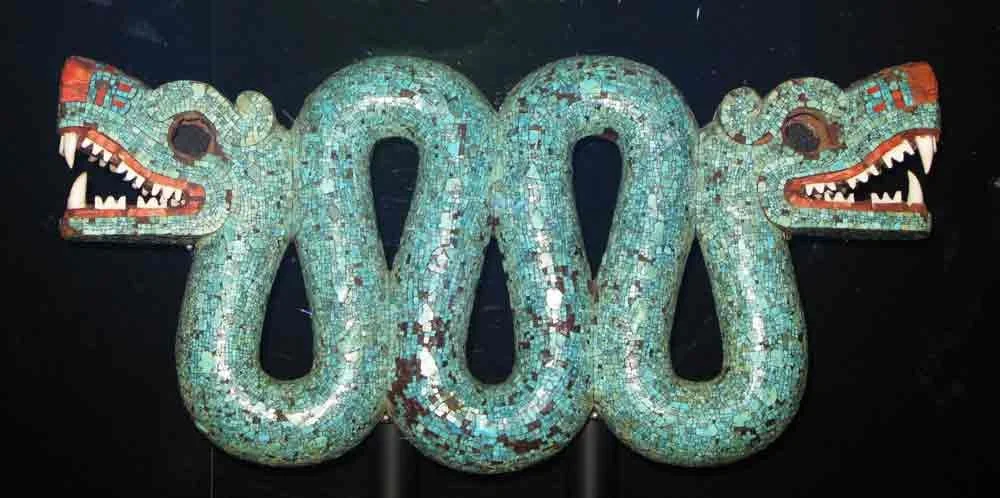THE AZTECS: PART 2
Start watching at about 6:58 (almost 7 minutes)
START when you hear him say, “Hey, do you remember how the Maya worked to make their gods happy?”
What offerings did the Aztecs make to their gods? List more than one!
Why did they make these offerings?
Who ruled over the Aztec people? Who was their leader?
Who helped the leader rule?
The leader lead the military. What else did he take part in?
Which city do historians think was the largest ancient city in North America?
What ancient Aztec technique for growing vegetables is still used today?
When the Aztecs conquered other peoples they didn’t rule over them. What else did they do?
Today’s maize (or corn) is different from the maize in Aztec times. Explain.
Think back to Part 1: What is represented in the middle of the Mexican flag?
• Read •
THE AZTECS: PART 2
The Aztecs believed in making their gods happy and made offerings of animals and humans. They thought this was super important to keep their gods on their side.
This was also important in how they were ruled. Their emperor was like a special link between the people and the gods. He basically ruled the city and everything around it.
The emperor wasn't alone in making decisions.
He had advisors, and the empire was divided into provinces, each with its own ruler.
These local bosses had to follow the emperor's rules but also managed their own areas. They collected taxes and made sure their province was doing well.
And the emperor was not just a political leader; he had other duties.
The emperor was in charge of the military and a lot more, but he also helped the high priest with religious rituals. The emperor and other nobles often took part in ceremonies and had a big say in how people worshipped.
So, the Aztecs were super organized in how they did things, from the way they governed their empire to how they worshipped their gods.
The Aztec's way of doing things worked so well that historians think Tenochtitlan was the largest ancient city in North America.
THE MOST POWERFUL EMPIRE
Time to break out your thinking cap: How did the Aztecs become the most powerful empire in Mesoamerica?
The Aztecs were famous for their strong army, which helped shape the incredible city of Tenochtitlan and the world around them.
The Aztecs were not just great fighters; they were also smart conquerors.
When they brought new lands under their rule, they didn't just take over; they shared their own ways of doing things. This mixing of cultures created a unique Mesoamerican culture, blending different traditions and ideas.
But make no mistake, the Aztecs were the mightiest folks around. Other folks knew it and usually created an alliance with the Aztecs because they knew they had little chance in defeating them.
This cultural diffusion made the empire even larger and spread Aztec culture even more. Like those chinampas, they were such a great idea that they're still used today.
Did you know that the maize or corn that we eat is a bit different from what the Aztecs had?
Over time, they carefully chose the best corn plants to grow, making the kernels bigger and the corn better. Historians think this occurred over decades, maybe even centuries.
So, the Aztecs were not just about battles and conquering; they were also about growing and sharing their knowledge, which helped make Tenochtitlan an amazing place.
Wow, we've learned so much about the Aztecs by making this visit to Tenochtitlan.
From their amazing city built on a lake to their powerful army and smart farming with chinampas, the Aztecs were really impressive and showed us how a civilization can be both mighty and smart.
You already know that the Aztec's history is significant in Mexico's history and culture.
Advisors - People who give advice and help leaders make important decisions
Alliance - When two or more groups agree to work together and help each other
Ceremonies - Special events with specific actions and words, often for religious reasons
Chinampas - Floating gardens that the Aztecs built on lakes to grow crops
Civilization - A large group of people living together in an organized way with cities, government, and culture
Conquerors - People who take control of lands and people through fighting or force
Cultural diffusion - When ideas, customs, and ways of life spread from one group of people to another
Empire - A large area of land and many people ruled by one powerful leader
Historians - People who study and write about what happened in the past
Maize - The type of corn that Native Americans grew (different from our corn today)
Mesoamerica - The area that includes Mexico and Central America where ancient civilizations lived
Nobles - People from important, wealthy families who have special rights and power
Offerings - Gifts given to gods or important people, often as part of religious practices
Provinces - Different areas or regions within a larger empire or country
Rituals - Special ceremonies or actions that are done the same way each time, often for religious reasons
► COMPREHENSION QUESTIONS
— please answer with complete sentences
What offerings did the Aztecs make to their gods? List more than one!
Why did they make these offerings?
Who ruled over the Aztec people? Who was their leader?
Who helped the leader rule?
The leader lead the military. What else did he take part in?
Which city do historians think was the largest ancient city in North America?
What ancient Aztec technique for growing vegetables is still used today?
When the Aztecs conquered other peoples they didn’t rule over them. What else did they do?
Today’s maize (or corn) is different from the maize in Aztec times. Explain.
Think back to Part 1: What is represented in the middle of the Mexican flag?



















